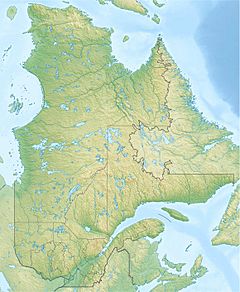Rivière des Renards facts for kids
Quick facts for kids Rivière des Renards |
|
|---|---|

Rivière des Renards upstream of the rang 6 and 7 bridge in St-Ludger.
|
|
| Country | Canada |
| Province | Quebec |
| Region | Estrie |
| MRC | Le Granit Regional County Municipality |
| Physical characteristics | |
| Main source | Mountain streams Saint-Ludger, (MRC) Le Granit Regional County Municipality, Québec 601 metres (1,972 ft) 45°36′45″N 70°37′42″W / 45.612464°N 70.628416°W |
| River mouth | Rivière du Barrage Saint-Ludger 397 metres (1,302 ft) 45°40′49″N 70°40′32″W / 45.68028°N 70.67555°W |
| Length | 7.8 kilometres (4.8 mi) |
| Basin features | |
| Progression | Rivière du Barrage, Samson River, Chaudière River, St. Lawrence River |
| River system | St. Lawrence River |
| Tributaries |
|
The Rivière des Renards (which means "river of foxes" in English) is a cool river located in Quebec, Canada. It's a smaller river that flows into the Rivière du Barrage, which then joins the Samson River. Eventually, its waters travel all the way to the mighty St. Lawrence River!
River's Journey
The Rivière des Renards starts high up in the mountains of Saint-Ludger, Quebec. It begins from small mountain streams at an elevation of about 601 meters (that's over 1,970 feet!).
From there, the river flows for about 7.8 kilometers (nearly 5 miles). It winds its way through the beautiful landscape of the Le Granit Regional County Municipality.
Where It Ends
The journey of the Rivière des Renards ends when it flows into the Rivière du Barrage. This happens also in the area of Saint-Ludger. At this point, the river is at an elevation of about 397 meters (around 1,300 feet).
After joining the Rivière du Barrage, its waters continue to flow into the Samson River. The Samson River then empties into the larger Chaudière River, which finally reaches the huge St. Lawrence River. So, the water from this small river travels a long way!
River's Name
The name "Rivière des Renards" means "river of foxes." It's likely named after the foxes that might have lived or still live near its banks.
The official name for this river was decided on February 28, 1980. This was done by the Commission de toponymie du Québec, which is a group in Quebec that gives official names to places and geographical features.


